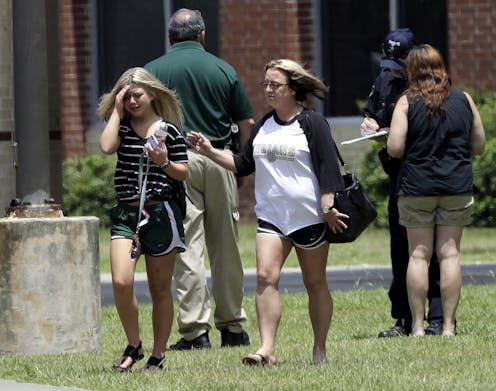Improving school climate, not just security, is key to violence prevention
- Written by F. Chris Curran, Assistant Professor of Public Policy, University of Maryland, Baltimore County

School shootings like the one that took place[1] in Santa Fe, Texas, on May 18 are often followed by calls[2] for enhanced security measures[3].
But Santa Fe High School already had many of these security measures in place.
For instance, the high school had a school resource officer who responded to the attack[4]. The school also had security cameras[5] in place and had recently conducted active shooting training and drills[6].
As the nation searches for ways to prevent school violence, the focus must be as much on school climate and culture as it is on school security. I make this argument as an educational researcher[7] who studies school safety.
Calls for beefed up security
Many of the security measures in place at Santa Fe High School were called for in the wake of the Feb. 14 school shooting in Parkland, Florida[8]. For instance, several states have passed legislation to increase law enforcement presence[9] at schools. The federal government expanded funding[10] to support the use of security measures such as metal detectors as well as training for threat identification and emergency response.
Beyond the school walls, there have been broader calls for gun control[11]. It is notable that the weapons used in the attack are reported[12] to have been owned legally by the father of the shooter and were not the type targeted by most gun control proposals.
One area that often gets overlooked in the aftermath of these tragedies is school culture. News reports indicate the shooter was reportedly bullied[13] by other students and coaching staff. School officials, however, dispute[14] this account.
An examination of the school culture at Santa Fe High School could prove as important as a review of the school security measures that were in place and the extent to which they were followed.
Why school climate matters
Research[15] has consistently shown that positive school climate is a strong predictor of school safety. When students have healthy peer relationships[16], teachers they trust[17], and school policies that they perceive as fair[18], they are more likely to feel safe in the school and less likely to misbehave.
Building a sense of community[19] among students and adults in schools may reduce the risk of school violence.
Some advocates have called for a return to greater use of exclusionary[20] discipline practices like suspension.
Given the importance of supportive school climates for student safety, it is important to consider how the use of security measures and discipline practices that are meant to enhance safety might actually decrease it.
Unintended consequences of security
The use of visible security measures have been linked to lower measures of school safety[21]. Likewise, the research on the use of law enforcement in schools is at best mixed.
Prior work suggests that school resource officers can improve some measures of safety but can also result in more student arrests[22]. They may also contribute to the use of more punitive school disciplinary environments[23].
Research on school discipline[24] suggests that suspending students from school can weaken students’ ties to the school community. When such exclusion is perceived as unfair, as might be the case when arising from an overly prescriptive zero tolerance policy, the damage to school connectedness may be even more pronounced.
The need for a balanced approach
As policymakers and school leaders respond to the most recent school tragedy in Santa Fe, they should be mindful of the full implications of their choices for enhancing safety. The use of security measures like law enforcement may deter or minimize the damage of a school shooting, but their use must be balanced with approaches that enhance community within schools.
Luckily, there are promising approaches that schools can take to building trust and community among stakeholders.
The presence of school counselors and partnerships with community organizations[25] can help ensure that students have a trusted adult in the building and access to necessary mental health supports when needed. Restorative justice practices[26] have shown promise as an alternative to suspension. Such practices focus on the rebuilding of trust among the student and school community instead of excluding the student from school. Other anti-bullying efforts may also be considered as part of such an approach.
No student should have to fear for his or her life at school. Taking a multifaceted approach – one that balances security with community building – may help ensure that tragedies such as the one that unfolded in Santa Fe are fewer and further between.
References
- ^ the one that took place (www.nytimes.com)
- ^ calls (www.sun-sentinel.com)
- ^ enhanced security measures (www.newschannel5.com)
- ^ responded to the attack (www.chron.com)
- ^ security cameras (www.sfisd.org)
- ^ conducted active shooting training and drills (www.cbsnews.com)
- ^ educational researcher (scholar.google.com)
- ^ school shooting in Parkland, Florida (www.nbcnews.com)
- ^ increase law enforcement presence (www.campussafetymagazine.com)
- ^ expanded funding (www.congress.gov)
- ^ calls for gun control (www.cnn.com)
- ^ reported (www.nytimes.com)
- ^ bullied (www.aol.com)
- ^ dispute (www.facebook.com)
- ^ Research (journals.sagepub.com)
- ^ peer relationships (www.sciencedirect.com)
- ^ trust (consortium.uchicago.edu)
- ^ policies that they perceive as fair (link.springer.com)
- ^ sense of community (journals.sagepub.com)
- ^ return to greater use of exclusionary (www.usnews.com)
- ^ linked to lower measures of school safety (link.springer.com)
- ^ result in more student arrests (onlinelibrary.wiley.com)
- ^ punitive school disciplinary environments (link.springer.com)
- ^ Research on school discipline (journals.sagepub.com)
- ^ partnerships with community organizations (nepc.colorado.edu)
- ^ Restorative justice practices (www.wested.org)
Authors: F. Chris Curran, Assistant Professor of Public Policy, University of Maryland, Baltimore County

